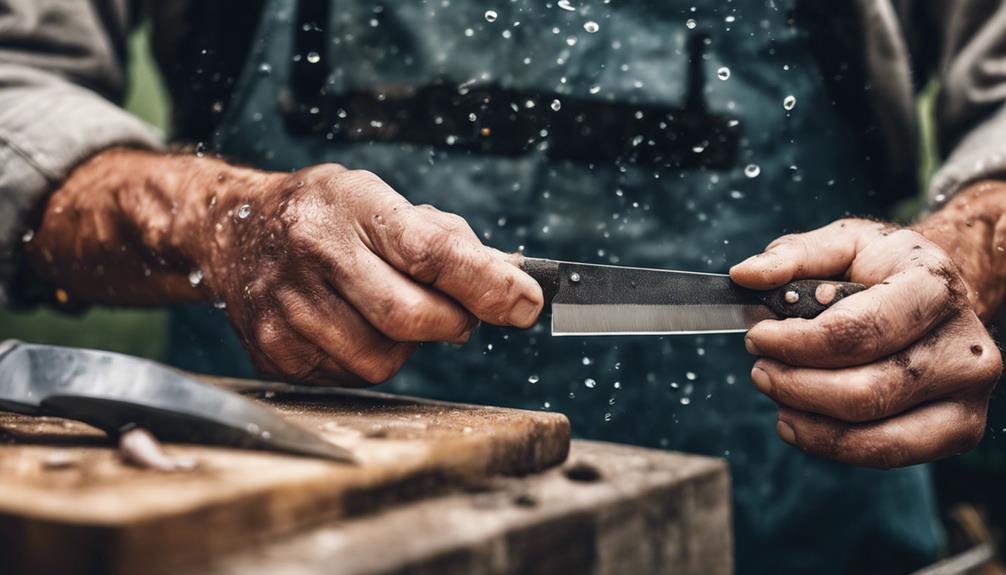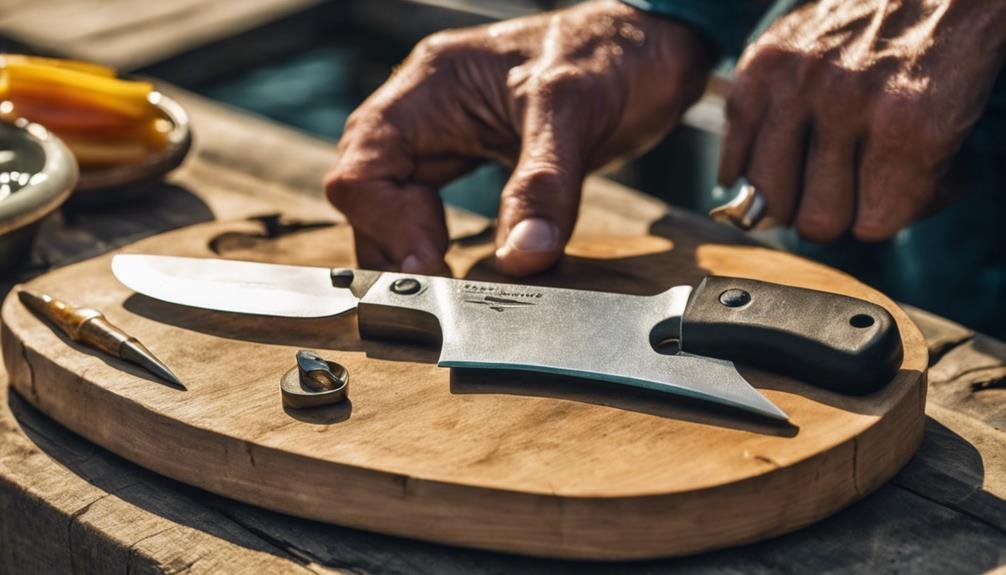To maintain the sharpness of your stainless steel fishing knife, you must adhere to proper maintenance practices. Ensuring your blade is sharp can greatly impact your fishing experience. Imagine effortlessly filleting your catch with precision and ease, all thanks to a well-maintained knife. But how can you achieve this level of sharpness and performance consistently? Let’s explore the essential steps and techniques to keep your stainless steel fishing knife in excellent condition for your next fishing adventure.
Key Takeaways
- Use diamond hones for the best sharpening results.
- Maintain a consistent angle of 15-20 degrees.
- Regularly hone with fine grit sharpening stone.
- Test sharpness by slicing through paper or tomato.
- Clean the knife thoroughly and apply oil to prevent rust.
Importance of Maintaining Blade Sharpness
Maintaining the sharpness of your stainless steel fishing knife is vital for ensuring efficient and precise fish filleting. A sharp blade reduces the need for excessive force, making cutting safer and more accurate. When filleting fish, a sharp knife produces cleaner cuts, preserving the quality and flavor of the fish by minimizing tissue damage. Regular maintenance of blade sharpness is important as it enhances the knife’s effectiveness and prolongs its longevity.
A properly sharpened stainless steel blade on your fillet knife offers several advantages. First, it makes the knife easier to handle, providing a smoother cutting experience. Second, a sharp blade ensures that you achieve precise cuts with minimal effort, improving the overall efficiency of the filleting process. Third, a sharp knife helps you work more effectively, saving time and energy while producing better results. By prioritizing sharpening your stainless steel fishing knife, you can elevate your filleting skills and optimize your fishing experience.
Choosing the Right Sharpening Tools
For ideal sharpening of your stainless steel fishing knife, consider selecting a sharpening tool that offers both fine and coarse sides on a sharpening stone. This versatility allows you to start with a coarser grit to reshape the blade and then use a finer grit for a polished, razor-sharp edge.
Look for a sharpening tool with adjustable angles to match the bevel of your fillet knife accurately. This ensures precise sharpening and prolongs the life of your blade. Tools like the Spyderco Sharpmaker offer a user-friendly design that simplifies the sharpening process, making it efficient and effective.
If you need a portable option for sharpening on the go, the Smiths Adjustable Angle Pull-Thru Knife Sharpener is a great choice for fillet knife sharpening. Additionally, a pocket mini-sharpener with ceramic rods can be a convenient tool to maintain the sharpness of your stainless steel fishing knife wherever you are.
Choose the right sharpening tool to keep your knife in top condition for all your fishing adventures.
Proper Angle for Sharpening Stainless Steel

To achieve prime sharpness for your stainless steel fishing knife, it is essential to ensure you are sharpening at the correct angle, typically around 15 to 20 degrees. Maintaining this angle consistently while sharpening is vital for peak blade sharpness and edge retention. Using a sharpening guide or system can ensure you maintain the proper angle throughout the sharpening process, preventing damage to the stainless steel blade and prolonging its lifespan.
Here is a table to illustrate the importance of the proper angle when sharpening stainless steel knives:
| Angle (degrees) | Edge Sharpness | Blade Lifespan | Filleting Precision |
|---|---|---|---|
| 10 | Lower | Shortened | Less precise |
| 15 | Medium | Standard | Moderate |
| 20 | Higher | Prolonged | Finer |
Sharpening your stainless steel fishing knife at a sharper angle, such as 15 degrees, can result in a finer edge, ideal for more delicate filleting tasks.
Maximizing Sharpness: High-Carbon Steel Blades for Fishing Knives
Techniques for Sharpening Stainless Steel Blade
Sharpening a stainless steel blade effectively requires utilizing diamond hones for best results.
When sharpening your stainless steel filet knife, employ techniques that involve a light touch to avoid causing flex issues common with this type of blade.
Consider using a bench stone to thin the edge geometry of the stainless steel blade, which can greatly enhance its cutting performance.
For quick touch-ups on the go, pocketable keychain hones like the DMT Mini-Sharp can be convenient tools to maintain the sharpness of your stainless steel blade.
Proper sharpening techniques ensure that your stainless steel fillet knife remains sharp and efficient for extended periods. By mastering these sharpening techniques and incorporating them into your regular maintenance routine, you can elevate the performance and longevity of your stainless steel fishing knife.
Regular Maintenance Tips for Sharpness

When maintaining the sharpness of your stainless steel fishing knife, regularly honing the blade is key to preserving its cutting performance. To achieve this, use a sharpening stone with fine grit to keep the edge razor-sharp.
When honing, apply light pressure to avoid damaging the steel. After sharpening, test the sharpness by slicing through a piece of paper or a tomato.
Proper maintenance goes beyond sharpening. Remember to clean the knife thoroughly and apply a thin layer of vegetable oil to prevent rust and corrosion. If used in saltwater environments, rinse the knife with fresh water and ensure it dries completely before oiling.
How Do I Keep My J.Marttiini Filleting Knife Sharp for Fishing and Camping Trips?
Use a sharpening stone or honing steel to keep your ultimate J.Marttiini filleting knife sharp for fishing and camping trips. Angle the blade at 20 degrees and stroke it across the stone or steel in a sweeping motion. Repeat on both sides to maintain a razor-sharp edge for precise cuts.
Conclusion
In fishing, a sharp stainless steel knife is your trusted companion. Like a well-honed blade, you must stay sharp and focused on your goals. Keep honing your skills and fine-tuning your techniques, and never let rust dull your shine.
Remember, just as a sharp knife is essential for success in fishing, staying sharp and prepared will lead you to your bountiful catch.
FAQs
Can Stainless Steel Knife Be Sharpened?
Yes, stainless steel knives can be sharpened using various techniques, including sharpening stones or rods. Regular maintenance, correct angle honing, and proper care can help maintain their edge retention and blade durability.
Different grades of stainless steel have varying hardness levels, which can affect the ease of sharpening. Whetstone options are available for sharpening as well.
How Do You Keep a Knife Super Sharp?
Focus on knife maintenance to keep a knife super sharp. Regularly hone the blade and use sharpening techniques, such as a sharpening stone.
Proper blade care is essential for edge retention. Follow a consistent honing process, maintaining the angle for cutting efficiency.
Store the knife in a dry place to prevent rust. Test the sharpness by slicing through a piece of paper or a tomato.
What Is the Best Sharpening Stone for Stainless Steel?
Consider diamond stones for sharpening stainless steel knives for their hardness and effectiveness. Ceramic stones offer fine grit for honing, while waterstones provide a smooth finish. Look for stones with a grit range of 1000-6000.
Guarantee the stone fits the knife’s size and thickness. Maintain the blade with proper sharpening techniques, honing processes, and polishing methods. Care for your knife by using appropriate sharpening angles and consistent blade maintenance.
How Do You Keep an Expensive Knife Sharp?
Focus on knife maintenance to keep an expensive knife sharp. Employ proper sharpening techniques and blade care. Regular honing processes are key for edge retention. Invest in quality knife sharpeners for blade durability.

